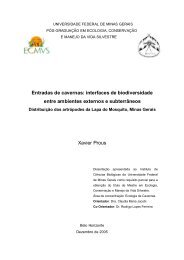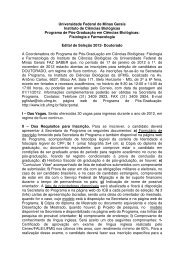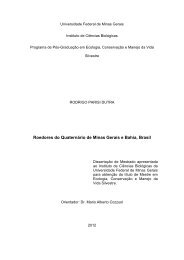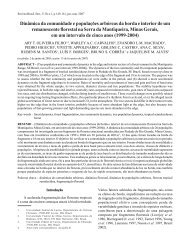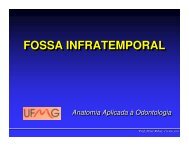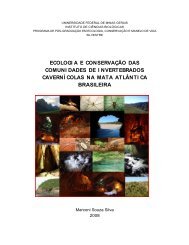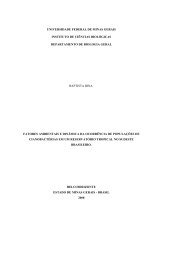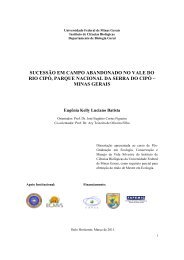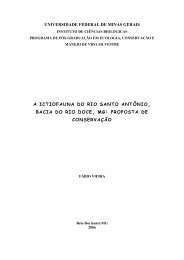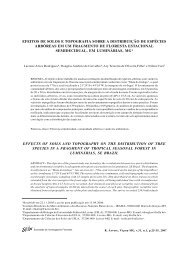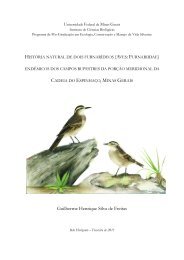Download : PDF - DCF - Departamento de Ciências Florestais ...
Download : PDF - DCF - Departamento de Ciências Florestais ...
Download : PDF - DCF - Departamento de Ciências Florestais ...
Create successful ePaper yourself
Turn your PDF publications into a flip-book with our unique Google optimized e-Paper software.
CARACTERIZAÇÃO ESTRUTURAL DE FLORESTA RIPÁRIA DO<br />
ALTO RIO GRANDE, EM MADRE DE DEUS DE MINAS, MG 1<br />
Enivanis <strong>de</strong> Abreu Vilela 2 , Ary Teixeira <strong>de</strong> Oliveira-Filho 3 , Douglas Antônio <strong>de</strong> Carvalho 2 ,<br />
Fre<strong>de</strong>rico Augusto Guimarães Guilherme 4 e Vivette Appolinário 4<br />
RESUMO: Foi inventariada uma floresta ripária, às margens do rio Gran<strong>de</strong>, no município <strong>de</strong> Madre <strong>de</strong> Deus <strong>de</strong><br />
Minas, MG, localizada nas coor<strong>de</strong>nadas 21º29’22”S e 44º22’35”W, a uma altitu<strong>de</strong> <strong>de</strong> 900 a 950 m e caracterizada<br />
como Floresta Estacional Semi<strong>de</strong>cidual Montana, nas encostas e como Floresta Estacional Semi<strong>de</strong>cidual Aluvial,<br />
no leito <strong>de</strong> inundação sazonal. O solo variou <strong>de</strong> Latossolo Vermelho-Amarelo distrófico-câmbico nas encostas, a<br />
Aluvial mesotrófico na área inundável. Foram <strong>de</strong>marcadas 71 parcelas contíguas <strong>de</strong> 15 × 15 m, perfazendo uma<br />
área amostral <strong>de</strong> 1,597 ha. Foram amostrados 1738 indivíduos com circunferência à altura do solo (CAS) ≥ 15.7<br />
cm, que se distribuíram em 47 famílias botânicas, 90 gêneros e 116 espécies. Dos indivíduos amostrados, 78,3%<br />
pertenciam a apenas <strong>de</strong>z famílias, sendo as três mais importantes: Myrtaceae (16,6%), Euphorbiaceae (10,0%) e<br />
Annonaceae (9,4%). As quatro famílias com maior número <strong>de</strong> espécies foram Myrtaceae (11), Fabaceae (9),<br />
Lauraceae (8) e Rubiaceae (8). As espécies mais abundantes nas encostas foram: Xylopia brasiliensis (150),<br />
Myrcia multiflora (119) e Geonoma schottiana (105). No leito <strong>de</strong> inundação, apenas duas espécies se <strong>de</strong>stacaram:<br />
Salix humboldtiana (104) e Inga vera (89) que representaram 95,1% dos indivíduos.<br />
PALAVRAS-CHAVE: Estrutura fitossociológica, floresta semi<strong>de</strong>cidual, floresta ripária.<br />
STRUCTURAL CHARACTERIZATION OF A PATCH OF RIPARIAN<br />
FOREST ALONG THE RIO GRANDE, IN MADRE DE DEUS DE MINAS,<br />
SE BRAZIL<br />
ABSTRACT: A survey was carried out in a patch of riparian forest lying along the Rio Gran<strong>de</strong> in Madre <strong>de</strong> Deus<br />
<strong>de</strong> Minas (21°29’22’’S, 44°22’35’’W, c. 900-950 m altitu<strong>de</strong>), state of Minas Gerais, south-eastern Brazil. The<br />
forest patch is characterised as Montane Semi<strong>de</strong>ciduous Seasonal Forest, on the upland slopes, and Alluvial<br />
Semi<strong>de</strong>ciduous Seasonal Forest, on the seasonally floo<strong>de</strong>d alluvial bed. The soils are Haplustox, on the slopes,<br />
and Ustifluvent, on the alluvial bed. The area was sampled with 71 (15 × 15 m) contiguous plots, totalling a<br />
sample area of 1,597 ha. A total of 1,738 trees with circumference at the base of the stem (cbt) ≥ 15.7 cm were<br />
recor<strong>de</strong>d in the sample. The trees were distributed in 116 species, 90 genera and 47 families. Most trees (78,3%)<br />
belonged to ten families, the most important of which were: Myrtaceae (16,6%), Euphorbiaceae (10,0%), and<br />
Annonaceae (9,4%). The four families with the higher number of species were Myrtaceae (11), Fabaceae (9),<br />
Lauraceae (8), and Rubiaceae (8). The most abundant species on the upland slopes were: Xylopia brasiliensis<br />
(150), Myrcia multiflora (119), and Geonoma schottiana (105). On the alluvial bed Salix humboldtiana (104)<br />
and Inga vera (89) encompassed 95,1% of all trees.<br />
KEY WORDS: Phytosociological structure, semi<strong>de</strong>ciduous forest, riparian forest.<br />
1 Projeto Mata Ciliar, Contrato CEMIG/UFLA/FAEPE.<br />
2 <strong>Departamento</strong> <strong>de</strong> Biologia/UFLA, CEP 37200-000, Lavras, MG. svilela@ufla.br; douglasc@ula.br.<br />
3 <strong>Departamento</strong> <strong>de</strong> Ciências <strong>Florestais</strong>, UFLA, CEP 37200-000, Lavras, MG. aryfilho@ufla.br.<br />
4 Estudante <strong>de</strong> mestrado em Engenharia Florestal na UFLA. fagg@ms.rc.unesp.br.<br />
CERNE, V.6, N.2, P.041-054, 2000
42<br />
VILELA, E. <strong>de</strong> A. et al.<br />
1. INTRODUÇÃO<br />
As florestas ripárias quase <strong>de</strong>sapareceram<br />
na região do alto Rio Gran<strong>de</strong> em razão dos cortes<br />
sem controle ocorridos no passado distante para<br />
fins diversos, basicamente ce<strong>de</strong>ndo espaço ao<br />
avanço da fronteira agrícola. Hoje restam<br />
pequenos fragmentos dispersos ao longo dos rios<br />
e tendo havido, ainda, recentemente, na maioria<br />
<strong>de</strong>les, algum tipo <strong>de</strong> corte seletivo.<br />
Preocupadas com esta situação, a<br />
Companhia Energética <strong>de</strong> Minas Gerais<br />
(CEMIG), a Universida<strong>de</strong> Fe<strong>de</strong>ral <strong>de</strong> Lavras<br />
(UFLA) e a Fundação <strong>de</strong> Apoio ao Ensino,<br />
Pesquisa e Extensão (FAEPE) firmaram no início<br />
<strong>de</strong> 1990, um contrato com o propósito <strong>de</strong> estudar<br />
a vegetação ripária, numa ação multidisciplinar,<br />
visando à implementação, a curto e médio<br />
prazos, <strong>de</strong> programas <strong>de</strong> recomposição florestal.<br />
Para isso, vários trabalhos foram executados nos<br />
ramos da botânica, ecologia, ecofisiologia, solos<br />
e silvicultura. Especificamente nos campos da<br />
botânica e ecologia dos fragmentos <strong>de</strong> floresta<br />
ripária, foram produzidos levantamentos<br />
florísticos e fitossociológicos, além <strong>de</strong> estudos<br />
ecológicos das relações entre a distribuição das<br />
espécies e variações dos fatores ambientais em<br />
seis fragmentos <strong>de</strong> floresta ripária nas regiões do<br />
Alto Rio Gran<strong>de</strong> (Carvalho et al., 1995a, b, c;<br />
Gavilanes et al., 1992; Oliveira-Filho et al.,<br />
1994a, b, c, d, 1995; Vilela et al., 1993, 1995a, b,<br />
c), Médio Rio Gran<strong>de</strong> (Carvalho et al., 1996a;<br />
Oliveira-Filho et al., 1995, 1997; Vilela,<br />
Oliveira-Filho e Carvalho, 1999), Baixo<br />
Paranaíba (Carvalho, Oliveira-Filho e Vilela,<br />
1996b, Oliveira-Filho et al., 1998, Vilela et al.,<br />
1998) e Alto São Francisco (Carvalho, Oliveira-<br />
Filho e Vilela, 1999, Vilela et al., 1998).<br />
No presente estudo são apresentados os<br />
resultados do levantamento fitossociológico<br />
conduzido em um fragmento <strong>de</strong> floresta ripária<br />
em Madre <strong>de</strong> Deus <strong>de</strong> Minas, com o propósito <strong>de</strong><br />
<strong>de</strong>screver a estrutura da comunida<strong>de</strong> arbórea dos<br />
dois tipos <strong>de</strong> floresta que ocorrem no fragmento.<br />
Este trabalho teve também o objetivo <strong>de</strong> prover<br />
informações botânicas e ecológicas para as<br />
iniciativas <strong>de</strong> recomposição da vegetação das<br />
margens do reservatório da Hidrelétrica <strong>de</strong><br />
Camargos (CEMIG).<br />
2. MATERIAL E MÉTODOS<br />
2.1. Caracterização da Área<br />
O estudo foi conduzido em um fragmento<br />
<strong>de</strong> 20 ha <strong>de</strong> floresta, situado às margens do Rio<br />
Gran<strong>de</strong>, em área pertencente à Fazenda<br />
Patrimônio (21°29’22’’S, 44º22’35’’W e<br />
altitu<strong>de</strong>s oscilando entre 900 e 950 m), no<br />
município <strong>de</strong> Madre <strong>de</strong> Deus <strong>de</strong> Minas, MG<br />
(Figura 1). Esta área situa-se numa curva interna<br />
do Rio Gran<strong>de</strong>, distante cerca <strong>de</strong> 4 km do início<br />
do represamento do Reservatório <strong>de</strong> Camargos.<br />
A fisionomia da floresta, segundo Veloso,<br />
Rangel Filho e Lima (1991), po<strong>de</strong> ser<br />
classificada como Floresta Estacional<br />
Semi<strong>de</strong>cidual Aluvial, nos leitos aluviais sujeitos<br />
a inundações sazonais e como Floresta<br />
Estacional Semi<strong>de</strong>cidual Montana, nas encostas<br />
adjacentes ao leito aluvial. O clima, conforme<br />
classificação <strong>de</strong> Köppen, é do tipo Cwb<br />
(mesotérmico com verões quentes e invernos<br />
secos), com temperatura média anual <strong>de</strong> 19,6ºC e<br />
precipitação pluviométrica média anual <strong>de</strong> 1517<br />
mm (93% ocorrendo entre os meses <strong>de</strong> outubro e<br />
abril). O solo, conforme o sistema brasileiro <strong>de</strong><br />
classificação, pertence a dois grupos: Aluvial<br />
mesotrófico, no leito aluvial e Latossolo<br />
Vermelho-Amarelo distrófico (câmbico), nas<br />
encostas.<br />
CERNE, V.6, N.2, P.041-054, 2000
Caracterização estrutural <strong>de</strong> floresta pipária...<br />
43<br />
Rio<br />
São<br />
Francisco<br />
Paranaíba<br />
Rio<br />
Rio<br />
Gran<strong>de</strong><br />
Rio<br />
Doce<br />
Madre <strong>de</strong> Deus <strong>de</strong><br />
Minas<br />
¤<br />
Figura 1. Situação geográfica do município <strong>de</strong> Madre <strong>de</strong> Deus <strong>de</strong> Minas, no estado <strong>de</strong> Minas Gerais e mapa da área <strong>de</strong> estudo<br />
mostrando a localização do setor florestal levantado (<strong>de</strong>limitado pelas duas linhas tracejadas). O pontilhado mais<br />
<strong>de</strong>nso representa florestas estacionais semi<strong>de</strong>ciduais montanas e o tracejado ao longo das margens do Rio Gran<strong>de</strong><br />
representam florestas estacionais semi<strong>de</strong>ciduais aluviais.<br />
Figure 1. Geographic situation of the municipality of Madre <strong>de</strong> Deus <strong>de</strong> Minas in the state of Minas Gerais and map of the study<br />
area showing the location of the surveyed forest tract (<strong>de</strong>limited by two dashed lines). Densely stippled areas<br />
represent montane seasonal semi<strong>de</strong>ciduous forests and dashed areas along the Rio Gran<strong>de</strong> margins represent alluvial<br />
seasonal semi<strong>de</strong>ciduous forests.<br />
CERNE, V.6, N.2, P.041-054, 2000
44<br />
VILELA, E. <strong>de</strong> A. et al.<br />
2.2. Levantamento dos dados<br />
O levantamento fitossociológico foi<br />
conduzido em 71 parcelas contíguas <strong>de</strong> 15 × 15<br />
m, totalizando uma área amostral <strong>de</strong> 1,597 ha,<br />
sendo 28 parcelas distribuídas sobre o aluvião e<br />
43 na encosta (Figura 2). Todos os indivíduos<br />
(árvores, arvoretas ou arbustos) <strong>de</strong>ntro das<br />
parcelas que tivessem circunferência à altura do<br />
solo (CAS) maior ou igual a 15,7 cm (diâmetro<br />
mínimo <strong>de</strong> 5 cm) foram registrados, medidos<br />
(CAS e altura) e tiveram amostras <strong>de</strong> material<br />
botânico coletadas para posterior i<strong>de</strong>ntificação.<br />
Estas amostras encontram-se incorporadas ao<br />
acervo do Herbário ESAL, da Universida<strong>de</strong><br />
Fe<strong>de</strong>ral <strong>de</strong> Lavras. As medições <strong>de</strong> altura foram<br />
estimadas por um só observador, tomando-se por<br />
base uma régua <strong>de</strong> comprimento conhecido (12,5<br />
m).<br />
I H G F<br />
E<br />
Figura 2. Distribuição das parcelas na área do levantamento,<br />
distinguindo-se os dois tipos florestais amostrados:<br />
cinza = florestas estacionais semi<strong>de</strong>ciduais<br />
montanas; branco = florestas estacionais<br />
semi<strong>de</strong>ciduais aluviais.<br />
Figure 2. Distribution of sample plots in the surveyed area<br />
showing the two forest types: grey = montane<br />
seasonal semi<strong>de</strong>ciduous forests; white = alluvial<br />
seasonal semi<strong>de</strong>ciduous forests.<br />
D<br />
C<br />
B<br />
A<br />
A<br />
B<br />
C<br />
D<br />
E<br />
F<br />
G<br />
H<br />
I<br />
J<br />
K<br />
L<br />
Para caracterizar a estrutura da comunida<strong>de</strong><br />
arbóreo-arbustiva da floresta, foram calculados,<br />
para cada espécie, os parâmetros<br />
fitossociológicos: <strong>de</strong>nsida<strong>de</strong> absoluta (DA),<br />
freqüência absoluta (FA), dominância absoluta<br />
(DoA) e índice <strong>de</strong> valor <strong>de</strong> importância (IVI),<br />
conforme Mueller-Dombois e Ellemberg (1974),<br />
o diâmetro médio (Dmed) e a altura máxima<br />
(Amax). Foram ainda obtidos o índice <strong>de</strong><br />
diversida<strong>de</strong> <strong>de</strong> espécies <strong>de</strong> Shannon-Weaver (H’)<br />
na base logarítma natural e a equabilida<strong>de</strong><br />
correspon<strong>de</strong>nte (J), segundo Brower e Zar<br />
(1984). Os cálculos foram feitos com auxílio do<br />
programa FITOPAC I, <strong>de</strong> George J. Shepherd<br />
(UNICAMP).<br />
3. RESULTADOS<br />
Foram i<strong>de</strong>ntificados 1.738 indivíduos<br />
distribuídos em 116 espécies, 90 gêneros e 47<br />
famílias botânicas (Tabelas 1 e 2). O índice <strong>de</strong><br />
diversida<strong>de</strong> <strong>de</strong> Shannon-Weaver foi<br />
sensivelmente superior na área <strong>de</strong> encosta (3,79<br />
nats/indivíduo), comparado com a <strong>de</strong> aluvião<br />
(0,93 nats/indivíduo). Isto reflete tanto a baixa<br />
riqueza <strong>de</strong> espécies da floresta aluvial (apenas<br />
oito espécies) como a forte concentração das<br />
abundâncias em apenas duas <strong>de</strong>las: Inga vera e<br />
Salix humboldtiana. Esta forte dominância das<br />
duas espécies resultou no baixo valor da<br />
equabilida<strong>de</strong> <strong>de</strong> Pielou: 0,45. Já na área <strong>de</strong><br />
encosta, on<strong>de</strong> foram encontradas 111 espécies, a<br />
equabilida<strong>de</strong> <strong>de</strong> 0,81 indica que a dominância é<br />
bem mais baixa.<br />
As duas florestas também se diferenciam<br />
fortemente quanto à fisionomia. A <strong>de</strong>nsida<strong>de</strong> é<br />
sensivelmente inferior na floresta aluvial (322,2<br />
indivíduos/ha, contra 1.586,6 indivíduos/ha, na<br />
floresta <strong>de</strong> encosta). Isto reflete na dominância<br />
total das duas florestas, expressa pela área basal:<br />
22,916 m 2 /ha, na floresta aluvial contra 53,135<br />
m 2 /ha, na flo-resta <strong>de</strong> encosta. Como a floresta<br />
aluvial é bem mais aberta, a gramínea<br />
Paspalum plenum<br />
CERNE, V.6, N.2, P.041-054, 2000
Caracterização estrutural <strong>de</strong> floresta pipária...<br />
45<br />
Tabela 1. Espécies arbóreas amostradas na floresta estacional semi<strong>de</strong>cidual montana da Fazenda Patrimônio, Madre <strong>de</strong> Deus <strong>de</strong><br />
Minas, Minas Gerais, com seus respectivos parâmetros fitossociológicos: N = número <strong>de</strong> indivíduos; P = número <strong>de</strong><br />
parcelas on<strong>de</strong> ocorre; AB = área basal total; diam = diâmetro médio; alt = altura máxima; DA = <strong>de</strong>nsida<strong>de</strong> absoluta;<br />
FA = freqüência absoluta; DoA = dominância absoluta; IVI = índice <strong>de</strong> valor <strong>de</strong> importância. Tamanho da amostra:<br />
43 parcelas <strong>de</strong> 15 × 15 m. Número <strong>de</strong> espécies: 111; H’ = 3,79; J’ = 0,81. Espécies or<strong>de</strong>nadas pelos valores<br />
<strong>de</strong>crescentes <strong>de</strong> IVI.<br />
Table 1. Tree species sampled in the montane seasonal semi<strong>de</strong>ciduous forest of Fazenda Patrimônio, Madre <strong>de</strong> Deus <strong>de</strong> Minas,<br />
Minas Gerais state, with their respective phytosociological parameters: N = number of individuals; P = number of<br />
plots with the species; AB = total basal area; diam = mean diameter; alt = maximum height; DA = absolute <strong>de</strong>nsity;<br />
FA = absolute frequency; DoA = absolute dominance; IVI = importance value in<strong>de</strong>x. Sample size: 43 plots of 15 × 15<br />
m. Number of species: 111; H’ = 3.79; J’ = 0.81. Species in <strong>de</strong>scending or<strong>de</strong>r of IVI.<br />
Espécies N P AB Diam. Alt. DA FA DoA IVI<br />
(m 2 ) (cm) (m) (in./ha) (%) (m 2 /ha)<br />
Xylopia brasiliensis 150 27 5,089 18,8 28,5 155,0 62,8 5,260 23,23<br />
Inga vera 50 11 6,285 34,6 17,0 51,7 25,6 6,496 16,93<br />
Myrcia multiflora 119 31 2,223 13,6 16,5 123,0 72,1 2,298 16,17<br />
Cryptocarya aschersoniana 50 24 4,390 29,4 28,5 51,7 55,8 4,537 14,96<br />
Trichilia emarginata 109 33 1,214 10,5 19,5 112,7 76,7 1,255 13,82<br />
Geonoma schottiana 105 21 0,419 7,0 10,0 108,5 48,8 0,433 10,43<br />
Actinostemon concolor 76 13 1,448 13,7 12,5 78,6 30,2 1,496 9,48<br />
Calyptranthes clusiifolia 63 29 0,687 10,5 15,0 65,1 67,4 0,710 9,27<br />
Alchornea triplinervea 41 24 1,529 18,0 24,0 42,4 55,8 1,581 8,81<br />
Copaifera langsdorffii 31 21 2,021 23,6 32,0 32,0 48,8 2,089 8,72<br />
Ocotea corymbosa 16 14 2,437 42,1 26,0 16,5 32,6 2,519 7,63<br />
Pera glabrata 38 21 0,946 15,5 23,5 39,3 48,8 0,978 7,09<br />
Ocotea odorifera 29 17 1,214 20,6 20,0 30,0 39,5 1,255 6,49<br />
Ixora warmingii 33 20 0,656 14,1 18,0 34,1 46,5 0,678 6,06<br />
Machaerium nictitans 24 17 1,033 21,4 22,5 24,8 39,5 1,068 5,82<br />
Miconia pusilliflora 24 14 1,155 22,6 20,5 24,8 32,6 1,194 5,66<br />
Amaioua guianensis 35 17 0,559 12,5 16,5 36,2 39,5 0,578 5,61<br />
Platycyamus regnellii 18 14 1,131 26,3 27,5 18,6 32,6 1,169 5,22<br />
Siparuna arianeae 32 18 0,122 6,8 11,0 33,1 41,9 0,127 4,70<br />
Machaerium villosum 10 8 1,533 41,9 22,0 10,3 18,6 1,585 4,69<br />
Eugenia neomyrtifolia 33 12 0,277 9,6 9,5 34,1 27,9 0,287 4,27<br />
Protium spruceanum 18 13 0,678 18,0 18,0 18,6 30,2 0,701 4,21<br />
Calophyllum brasiliense 18 15 0,456 15,7 14,5 18,6 34,9 0,471 4,04<br />
Marlierea racemosa 23 13 0,362 12,4 17,5 23,8 30,2 0,374 3,92<br />
Eugenia florida 19 12 0,540 17,5 11,5 19,6 27,9 0,558 3,87<br />
Leucochloron incuriale 12 12 0,685 22,1 23,0 12,4 27,9 0,708 3,70<br />
Aspidosperma parvifolium 9 8 1,031 30,0 23,0 9,3 18,6 1,066 3,65<br />
Prunus sellowii 24 12 0,182 9,3 15,0 24,8 27,9 0,189 3,50<br />
Humiriastrum glaziovii 12 9 0,649 20,2 26,5 12,4 20,9 0,671 3,23<br />
Picramnia glazioviana 16 14 0,100 8,4 10,5 16,5 32,6 0,103 3,08<br />
Hymenaea courbaril 6 4 1,005 41,3 33,0 6,2 9,3 1,039 2,87<br />
Tapirira guianensis 12 9 0,452 18,5 18,5 12,4 20,9 0,467 2,85<br />
Calycorectes acutatus 13 9 0,396 17,3 18,5 13,4 20,9 0,410 2,81<br />
Cordia sellowiana 10 7 0,573 25,1 30,0 10,3 16,3 0,592 2,69<br />
Cinnamomum glaziovii 4 3 0,947 46,6 22,5 4,1 7,0 0,979 2,50<br />
Faramea cyanea 14 9 0,201 12,0 19,0 14,5 20,9 0,208 2,49<br />
Annona cacans 7 7 0,442 27,8 20,5 7,2 16,3 0,457 2,24<br />
Coussapoa microcarpa 5 5 0,574 26,5 26,5 5,2 11,6 0,593 2,10<br />
Nectandra megapotamica 6 4 0,609 33,0 25,0 6,2 9,3 0,630 2,10<br />
Schefflera calva 8 6 0,364 20,4 18,5 8,3 14,0 0,376 2,02<br />
Alchornea glandulosa 10 6 0,187 13,1 17,0 10,3 14,0 0,193 1,81<br />
Continua...<br />
CERNE, V.6, N.2, P.041-054, 2000
46<br />
VILELA, E. <strong>de</strong> A. et al.<br />
Tabela 1. Cont.<br />
Espécies N P AB Diam. Alt. DA FA DoA IVI<br />
(m 2 ) (cm) (m) (in./ha) (%) (m 2 /ha)<br />
Gomi<strong>de</strong>sia tijucensis 10 7 0,057 8,1 9,5 10,3 16,3 0,059 1,69<br />
Croton floribundus 8 7 0,120 12,7 15,0 8,3 16,3 0,125 1,68<br />
Qualea multiflora 5 5 0,333 24,0 23,5 5,2 11,6 0,344 1,63<br />
Garcinia gardneriana 9 6 0,069 9,0 9,5 9,3 14,0 0,072 1,51<br />
Ficus mexiae 4 4 0,354 32,5 22,0 4,1 9,3 0,366 1,48<br />
Sloanea monosperma 8 5 0,133 13,0 20,5 8,3 11,6 0,137 1,44<br />
Cecropia pachystachya 6 6 0,111 14,7 12,5 6,2 14,0 0,115 1,40<br />
Zanthoxylum rhoifolium 6 6 0,109 14,2 12,5 6,2 14,0 0,112 1,39<br />
Connarus regnellii 5 4 0,171 16,7 23,5 5,2 9,3 0,177 1,19<br />
Prunus brasiliensis 7 5 0,040 8,0 11,5 7,2 11,6 0,041 1,19<br />
Mollinedia argyrogyna 5 5 0,087 14,6 13,0 5,2 11,6 0,090 1,15<br />
Maytenus glazioviana 5 4 0,134 15,0 20,5 5,2 9,3 0,138 1,11<br />
Andira fraxinifolia 5 5 0,039 9,1 12,0 5,2 11,6 0,040 1,06<br />
Aspidosperma spruceanum 5 3 0,172 14,8 30,0 5,2 7,0 0,178 1,06<br />
Salacia elliptica 4 3 0,207 18,2 17,0 4,1 7,0 0,214 1,06<br />
Psidium cattleianum 4 4 0,088 15,9 14,5 4,1 9,3 0,091 0,96<br />
Dalbergia villosa 3 3 0,180 26,0 23,5 3,1 7,0 0,186 0,94<br />
Tapirira obtusa 5 3 0,089 14,1 11,0 5,2 7,0 0,092 0,90<br />
Vismia brasiliensis 5 4 0,026 7,8 7,0 5,2 9,3 0,027 0,90<br />
Ocotea pulchella 2 2 0,208 30,7 17,0 2,1 4,7 0,215 0,80<br />
Rollinia sericea 3 3 0,097 20,2 16,5 3,1 7,0 0,100 0,78<br />
Casearia arborea 2 2 0,190 31,0 24,0 2,1 4,7 0,197 0,76<br />
Syagrus romanzoffiana 3 2 0,120 22,5 13,5 3,1 4,7 0,124 0,69<br />
Alibertia macrophylla 3 2 0,090 18,7 14,5 3,1 4,7 0,093 0,63<br />
Casearia obliqua 2 2 0,121 23,6 25,0 2,1 4,7 0,125 0,63<br />
Casearia sylvestris 3 3 0,021 8,8 12,5 3,1 7,0 0,021 0,63<br />
Cybianthus cuneifolius 3 3 0,014 7,5 6,0 3,1 7,0 0,015 0,62<br />
Hirtella hebeclada 3 3 0,015 7,9 10,0 3,1 7,0 0,015 0,62<br />
Maytenus salicifolia 3 3 0,009 6,0 6,0 3,1 7,0 0,009 0,61<br />
Psychotria carthagenensis 3 3 0,012 6,9 9,5 3,1 7,0 0,012 0,61<br />
Vochysia bifalcata 2 2 0,110 21,6 20,0 2,1 4,7 0,114 0,61<br />
Sizygium jambos 2 2 0,105 24,5 12,5 2,1 4,7 0,109 0,60<br />
Machaerium hirtum 3 2 0,065 15,9 11,0 3,1 4,7 0,067 0,58<br />
Nectandra oppositifolia 2 2 0,065 18,0 23,5 2,1 4,7 0,067 0,52<br />
Euplassa incana 1 1 0,158 44,9 18,5 1,0 2,3 0,164 0,50<br />
Tovomitopsis saldanhae 2 2 0,056 18,6 16,5 2,1 4,7 0,058 0,50<br />
Miconia cinnamomifolia 3 2 0,015 7,9 9,5 3,1 4,7 0,015 0,49<br />
Miconia argyrophylla 3 2 0,010 6,4 6,5 3,1 4,7 0,010 0,48<br />
Protium heptaphyllum 3 2 0,009 6,2 8,5 3,1 4,7 0,009 0,48<br />
Styrax pohli 2 2 0,042 16,2 22,5 2,1 4,7 0,043 0,48<br />
Terminalia glabrescens 2 2 0,046 17,0 13,5 2,1 4,7 0,047 0,48<br />
Rollinia sylvatica 2 2 0,032 13,4 11,0 2,1 4,7 0,033 0,46<br />
Chomelia sericea 2 2 0,028 13,0 8,0 2,1 4,7 0,029 0,45<br />
Roupala brasiliensis 2 2 0,021 10,7 12,0 2,1 4,7 0,022 0,44<br />
Solanum leuco<strong>de</strong>ndron 2 2 0,021 10,8 16,0 2,1 4,7 0,021 0,43<br />
Dendropanax cuneatum 2 2 0,012 8,1 11,5 2,1 4,7 0,012 0,42<br />
Cupania vernalis 2 2 0,008 7,2 7,0 2,1 4,7 0,008 0,41<br />
Dalbergia nigra 2 2 0,006 6,2 5,5 2,1 4,7 0,006 0,41<br />
Matayba elaeagnoi<strong>de</strong>s 2 2 0,005 5,7 11,5 2,1 4,7 0,005 0,40<br />
Cabralea canjerana 1 1 0,088 33,4 15,0 1,0 2,3 0,091 0,37<br />
Psychotria sessilis 3 1 0,009 6,2 2,5 3,1 2,3 0,009 0,34<br />
Continua...<br />
CERNE, V.6, N.2, P.041-054, 2000
Caracterização estrutural <strong>de</strong> floresta pipária...<br />
47<br />
Tabela 1. Cont.<br />
Espécies N P AB Diam. Alt. DA FA DoA IVI<br />
(m 2 ) (cm) (m) (in./ha) (%) (m 2 /ha)<br />
Guapira opposita 1 1 0,054 26,1 11,5 1,0 2,3 0,055 0,30<br />
Sorocea bonplandii 1 1 0,046 24,2 9,5 1,0 2,3 0,048 0,29<br />
Blepharocalyx salicifolius 1 1 0,037 21,6 13,0 1,0 2,3 0,038 0,27<br />
Daphnopsis fasciculata 1 1 0,032 20,0 11,5 1,0 2,3 0,033 0,26<br />
Ocotea brachybotra 1 1 0,021 16,2 11,0 1,0 2,3 0,021 0,24<br />
Myrcia tomentosa 1 1 0,022 16,9 12,5 1,0 2,3 0,023 0,24<br />
Jacaranda macrantha 1 1 0,015 14,0 9,0 1,0 2,3 0,016 0,23<br />
Pseudobombax grandiflorum 1 1 0,016 14,3 9,0 1,0 2,3 0,017 0,23<br />
Virola oleifera 1 1 0,011 11,8 10,0 1,0 2,3 0,011 0,22<br />
Lacistema hasslerianum 1 1 0,006 8,9 5,0 1,0 2,3 0,006 0,21<br />
Actinostemon klotzschii 1 1 0,002 5,4 3,0 1,0 2,3 0,002 0,20<br />
Guatteria nigrescens 1 1 0,003 5,7 4,0 1,0 2,3 0,003 0,20<br />
Machaerium stipitatum 1 1 0,003 6,1 6,5 1,0 2,3 0,003 0,20<br />
Myrsine umbellata 1 1 0,003 6,1 11,5 1,0 2,3 0,003 0,20<br />
Ocotea diospyrifolia 1 1 0,004 6,7 6,0 1,0 2,3 0,004 0,20<br />
Ormosia arborea 1 1 0,003 5,7 2,0 1,0 2,3 0,003 0,20<br />
Piper gaudichaudianum 1 1 0,003 5,7 3,5 1,0 2,3 0,003 0,20<br />
Psychotria <strong>de</strong>flexa 1 1 0,003 6,1 3,5 1,0 2,3 0,003 0,20<br />
Tabebuia heptaphylla 1 1 0,003 5,7 6,0 1,0 2,3 0,003 0,20<br />
TOTAIS 1535 51,409 1586,6 53,135<br />
Tabela 2. Espécies arbóreas amostradas na floresta estacional semi<strong>de</strong>cidual aluvial da Fazenda Patrimônio, Madre <strong>de</strong> Deus <strong>de</strong><br />
Minas, Minas Gerais, com seus respectivos parâmetros fitossociológicos: N = número <strong>de</strong> indivíduos; P = número <strong>de</strong><br />
parcelas on<strong>de</strong> ocorre; AB = área basal total; diam = diâmetro médio; alt = altura máxima; DA = <strong>de</strong>nsida<strong>de</strong> absoluta;<br />
FA = freqüência absoluta; DoA = dominância absoluta; IVI = índice <strong>de</strong> valor <strong>de</strong> importância. Tamanho da amostra:<br />
28 parcelas <strong>de</strong> 225 m 2 . Número <strong>de</strong> espécies: 8; H’ = 0,93; J’ = 0,45. Espécies or<strong>de</strong>nadas pelos valores <strong>de</strong>crescentes <strong>de</strong><br />
IVI.<br />
Table 2. Tree species sampled in the alluvial seasonal semi<strong>de</strong>ciduous forest of Fazenda Patrimônio, Madre <strong>de</strong> Deus <strong>de</strong> Minas,<br />
Minas Gerais state, with their respective phytosociological parameters: N = number of individuals; P = number of<br />
plots with the species; AB = total basal area; diam = mean diameter; alt = maximum height; DA = absolute <strong>de</strong>nsity;<br />
FA = absolute frequency; DoA = absolute dominance; IVI = importance value in<strong>de</strong>x. Sample size: 28 plots of 225 m 2 .<br />
Number of species: 8; H’ = 0.93; J’ = 045. Species in <strong>de</strong>scending or<strong>de</strong>r of IVI.<br />
Espécies N P AB Diam. Alt. DA FA DoA IVI<br />
(m 2 ) (cm) (m) (in./ha) (%) (m 2 /ha)<br />
Inga vera 89 21 9,748 31,0 13,5 141,3 75,0 15,473 165,21<br />
Salix humboldtiana 104 10 4,596 21,1 14,5 165,1 35,7 7,295 108,71<br />
Acacia recurva 4 2 0,062 12,3 9,5 6,3 7,1 0,099 7,53<br />
Psychotria carthagenensis 2 2 0,006 5,9 2,5 3,2 7,1 0,009 6,15<br />
Eugenia neomyrtifolia 1 1 0,011 11,8 4,0 1,6 3,6 0,017 3,13<br />
Ludwigia suffruticosa 1 1 0,009 10,8 3,5 1,6 3,6 0,015 3,12<br />
Croton urucurana 1 1 0,003 6,4 3,0 1,6 3,6 0,005 3,08<br />
Solanum granuloso-leprosum 1 1 0,002 5,4 3,5 1,6 3,6 0,004 3,07<br />
TOTAIS 203 14,437 322,2 22,916<br />
CERNE, V.6, N.2, P.041-054, 2000
48<br />
VILELA, E. <strong>de</strong> A. et al.<br />
(capituva) reveste o sub-bosque e são poucos os<br />
imaturos <strong>de</strong> espécies arbóreas se estabelecendo.<br />
O limite entre as duas florestas é brusco e<br />
caracterizado por uma <strong>de</strong>nsa ‘pare<strong>de</strong> <strong>de</strong> folhas’<br />
que se esten<strong>de</strong> do solo às copas das árvores.<br />
As <strong>de</strong>z famílias mais abundantes na área <strong>de</strong><br />
encosta contribuíram com 78,3% dos indivíduos<br />
amostrados, sendo que Myrtaceae contribuiu<br />
com 16,57%, seguida <strong>de</strong> Euphorbiaceae<br />
(10,01%) e Annonaceae (9,38%) (Figura 3).<br />
Com relação à distribuição das famílias em<br />
função do índice <strong>de</strong> valor <strong>de</strong> importância (IVI),<br />
observa-se que, na área <strong>de</strong> encosta, Myrtaceae<br />
foi a mais representativa (44,07), seguida <strong>de</strong><br />
Lauraceae (35,20) e Euphorbiaceae (28,87).<br />
Entretanto, na área aluvial, Mimosaceae foi a<br />
mais importante (165,21), seguida <strong>de</strong> Salicaceae<br />
(108,71) (Figura 4). Analisando as famílias por<br />
número <strong>de</strong> espécies, constatou-se que Myrtaceae<br />
foi a que apresentou maior número <strong>de</strong> espécies<br />
(11), seguida <strong>de</strong> Fabaceae (9), Lauraceae (8) e<br />
Rubiaceae (8) (Figura 5).<br />
As espécies com os maiores índices <strong>de</strong><br />
valor <strong>de</strong> importância na área <strong>de</strong> encosta foram<br />
Xylopia brasiliensis (23,23), Inga vera (16,93) e<br />
Myrcia multiflora (16,17) (Tabela 1). Já na área<br />
aluvial, duas espécies arbóreas se <strong>de</strong>stacaram:<br />
Inga vera (165,21) e Salix humboldtiana<br />
(108,71) (Tabela 2). Quanto ao número <strong>de</strong><br />
indivíduos amostrados por espécie na área <strong>de</strong><br />
encosta, 58,92% estavam representados por<br />
apenas <strong>de</strong>z espécies, sendo que as três mais<br />
numerosas foram Xylopia brasiliensis (150),<br />
Myrcia multiflora (119) e Geonoma schottiana<br />
(105). Na floresta aluvial, Salix humboldtiana<br />
(104) e Inga vera (89) representaram 95,1% <strong>de</strong><br />
todos os indivíduos. Quanto à distribuição das<br />
espécies na área, expressa pela freqüência<br />
absoluta, Trichillia emarginata foi a mais bem<br />
distribuída na área <strong>de</strong> encosta (76,7%), seguida<br />
FABACEAE<br />
RUBIACEAE<br />
LAURACEAE<br />
67<br />
94<br />
98<br />
37 Famílias remanescentes:<br />
377 indivíduos (21,7%)<br />
SALICACEAE<br />
104<br />
ARECACEAE<br />
108<br />
MELIACEAE<br />
110<br />
MIMOSACEAE<br />
ANNONACEAE<br />
EUPHORBIACEAE<br />
155<br />
163<br />
174<br />
MYRTACEAE<br />
288<br />
0 50 100 150 200 250 300<br />
NÚMERO DE INDIVÍDUOS<br />
Figura 3. Distribuição, por família botânica, do número <strong>de</strong> indivíduos amostrados na floresta ripária <strong>de</strong> Madre <strong>de</strong> Deus <strong>de</strong> Minas.<br />
Figure 3. Distribution of the number of individuals per botanic family in the riparian forest of Madre <strong>de</strong> Deus <strong>de</strong> Minas.<br />
CERNE, V.6, N.2, P.041-054, 2000
Caracterização estrutural <strong>de</strong> floresta pipária...<br />
49<br />
CLUSIACEAE<br />
6,95<br />
ARECACEAE<br />
MELIACEAE<br />
RUBIACEAE<br />
FABACEAE<br />
MIMOSACEAE<br />
11,12<br />
14,19<br />
16,39<br />
18,92<br />
20,63<br />
ANNONACEAE<br />
EUPHORBIACEAE<br />
26,91<br />
28,87<br />
LAURACEAE<br />
36,2<br />
MYRTACEAE<br />
44,07<br />
0 10 20 30 40 50<br />
Figura 4. Distribuição, por família botânica, do índice <strong>de</strong> valor <strong>de</strong> importância (IVI) na floresta ripária <strong>de</strong> Madre <strong>de</strong> Deus <strong>de</strong><br />
Minas.<br />
Figure 4. Distribution of the importance value in<strong>de</strong>x (IVI) per botanic family in the riparian forest of Madre <strong>de</strong> Deus <strong>de</strong> Minas.<br />
IVI<br />
<strong>de</strong> Myrcia multiflora (72,1%), Calyptranthes<br />
clusiaefolia (67,74%) e Xylopia brasiliensis<br />
(62,8%). Já na área aluvial, sobressaíram-se Inga<br />
vera (75%) e Salix humboldtiana (35,7%). A<br />
expressão da dominância das espécies pela sua<br />
área basal indicou como mais dominantes na área<br />
<strong>de</strong> encosta Inga vera (6,496m 2 /ha), Xylopia<br />
brasilensis (5,260m 2 /ha) e Cryptocarya<br />
aschersoniana (4,537m 2 /ha). Na área aluvial,<br />
estas foram Inga vera (15,473m 2 /ha) e Salix<br />
humboldtiana (7,295m 2 /ha).<br />
A distribuição espacial das espécies <strong>de</strong><br />
plantas em comunida<strong>de</strong>s ripárias é fortemente<br />
afetada por aspectos geomorfológicos, pois estes<br />
estão normalmente associados com diferenças no<br />
regime <strong>de</strong> água do solo ou <strong>de</strong> inundação, bem<br />
como com catenas <strong>de</strong> solo (Brinson, 1990). Na<br />
bacia Amazônica, a classificação <strong>de</strong> zonas<br />
ripárias baseada na geomorfologia tem se<br />
mostrado uma abordagem muito eficiente, na<br />
medida que as características topográficas<br />
correspon<strong>de</strong>m muito claramente a diferentes<br />
tipos <strong>de</strong> vegetação e condições ambientais<br />
(Kalliola et al., 1991; Worbes et al., 1992;<br />
Puhakka et al., 1992). No presente caso, as áreas<br />
<strong>de</strong> aluvião e encosta diferenciam-se fortemente<br />
em termos <strong>de</strong> características dos solos, regime <strong>de</strong><br />
inundação e, consequentemente, estrutura da<br />
comunida<strong>de</strong> florestal.<br />
CERNE, V.6, N.2, P.041-054, 2000
50<br />
VILELA, E. <strong>de</strong> A. et al.<br />
3<br />
3<br />
3<br />
4<br />
5<br />
37 Famílias remanescentes:<br />
56 espécies (48,28%)<br />
6<br />
8<br />
8<br />
9<br />
11<br />
0 2 4 6 8 10 12<br />
NÚMERO DE ESPÉCIES<br />
Figura 5. Distribuição, por família botânica, do número <strong>de</strong> espécies amostradas na floresta ripária <strong>de</strong> Madre <strong>de</strong> Deus <strong>de</strong> Minas.<br />
Figure 5. Distribution of the number of species per botanic family in the riparian forest of Madre <strong>de</strong> Deus <strong>de</strong> Minas.<br />
A brusca transição entre as florestas aluvial<br />
e <strong>de</strong> encosta na área <strong>de</strong> estudos é uma<br />
conseqüência direta das inundações sazonais.<br />
Áreas ribeirinhas periodicamente alagáveis são<br />
invariavelmente cobertas por tipos particulares<br />
<strong>de</strong> vegetação, que são compostos por espécies<br />
capazes <strong>de</strong> sobreviver às inundações <strong>de</strong>vido a<br />
estratégias <strong>de</strong> escape ou tolerância ao estresse<br />
hídrico. Além do mais, freqüentemente, as<br />
plantas também têm que enfrentar a dinâmica <strong>de</strong><br />
sedimentação que está associada às inundações<br />
(Junk, 1990). Distúrbios causados pelos ciclos <strong>de</strong><br />
inundação certamente causam muita<br />
instabilida<strong>de</strong> ambiental, a qual, em geral,<br />
mantém a vegetação dos leitos aluviais sob<br />
<strong>de</strong>morados estádios <strong>de</strong> sucessão (Puhakka et al.,<br />
1992). Portanto, na área <strong>de</strong> estudos, a vegetação<br />
muito distinta da área <strong>de</strong> aluvião provavelmente<br />
representa os estádios iniciais <strong>de</strong> um processo <strong>de</strong><br />
sucessão primária que <strong>de</strong>pen<strong>de</strong> das taxas locais<br />
<strong>de</strong> sedimentação para avançar, retroce<strong>de</strong>r ou<br />
estagnar.<br />
A gramínea Paspalum plenum, ou capituva,<br />
que reveste o sub-bosque da floresta da área<br />
aluvial, cresce tipicamente em baixios com águas<br />
rasas (Hitchcock, 1930) e é comumente<br />
encontrada nas margens <strong>de</strong> rios no su<strong>de</strong>ste do<br />
Brasil. Na área <strong>de</strong> estudos, a capituva cresce<br />
mais <strong>de</strong>nsa e alta a pleno sol e on<strong>de</strong> a água das<br />
inundações não submerge suas folhas. Sombra<br />
parcial, como aquela projetada pela folhagem<br />
aberta dos maciços <strong>de</strong> salgueiro (Salix<br />
humboldtiana) ou por árvores esparsas <strong>de</strong> ingá<br />
(Inga vera), restringe pouco o crescimento da<br />
capituva. A espécie só se torna quase ausente<br />
on<strong>de</strong> os ingás formam um dossel mais fechado e<br />
contínuo. Portanto, esta gramínea é<br />
provavelmente uma espécie pioneira inicial, que<br />
coloniza os aluviões on<strong>de</strong> e quando a<br />
profundida<strong>de</strong> das inundações alcança um<br />
máximo tolerável. As árvores <strong>de</strong> salgueiro e ingá<br />
CERNE, V.6, N.2, P.041-054, 2000
Caracterização estrutural <strong>de</strong> floresta pipária...<br />
51<br />
provavelmente se estabelecem no estádio<br />
subseqüente <strong>de</strong> sucessão e, à medida que suas<br />
copas aumentam o sombreamento do subbosque,<br />
o crescimento da capituva é<br />
<strong>de</strong>sfavorecido. Por outro lado, não se sabe se as<br />
touceiras <strong>de</strong> capituva favorecem ou<br />
<strong>de</strong>sfavorecem o estabelecimento dos salgueiros e<br />
ingás.<br />
Gramíneas <strong>de</strong> alto porte, como a capituva,<br />
também são mencionadas por Junk (1990) and<br />
Worbes et al. (1990) como predominantes no<br />
estádio inicial <strong>de</strong> sucessão primária que ocorre<br />
nas várzeas da Amazônia Central. Este autores<br />
também afirmam que este primeiro passo é<br />
seguido, <strong>de</strong> forma parecida à área <strong>de</strong> estudos, por<br />
uma floresta monodominante <strong>de</strong> Salix<br />
humboldtiana. Densas populações <strong>de</strong>sta espécie<br />
ao longo <strong>de</strong> instáveis margens <strong>de</strong> rios também<br />
foram registradas para o estado <strong>de</strong> São Paulo<br />
(Mantovani et al., 1989). Junk (1990) atribui a<br />
abundância <strong>de</strong> Salix nos estágios iniciais <strong>de</strong><br />
sucessão à sua habilida<strong>de</strong> <strong>de</strong> resistir à rápida<br />
sedimentação, <strong>de</strong>vido à produção <strong>de</strong> novas raízes<br />
laterais, à medida que o tronco vai sendo<br />
soterrado. Algumas populações <strong>de</strong> salgueiros<br />
observadas nas barrancas erodidas do Rio<br />
Gran<strong>de</strong> mostravam várias camadas <strong>de</strong> raízes e<br />
algumas conecções subterrâneas entre árvores.<br />
Portanto, é provável que a distribuição agregada,<br />
tão comum nestas populações, se <strong>de</strong>va, pelo<br />
menos em parte, à propagação vegetativa.<br />
Também na área <strong>de</strong> estudos, a população <strong>de</strong><br />
Salix mostrou-se muito mais agregada que a <strong>de</strong><br />
Inga, uma vez que ocorreu em um número bem<br />
menor <strong>de</strong> parcelas, apesar do número <strong>de</strong><br />
indivíduos superior ao <strong>de</strong> Inga.<br />
Espécies do gênero Inga são<br />
particularmente comuns em margens <strong>de</strong> rios em<br />
toda a região neotropical, sendo Inga vera uma<br />
das mais amplamente distribuídas (Pennington,<br />
1997). Aparentemente, a espécie cresce em sítios<br />
menos instáveis do que aqueles dominados pelo<br />
salgueiro (Oliveira-Filho et al., 1994a) e é<br />
encontrada também nas partes mais baixas da<br />
floresta <strong>de</strong> encosta. Portanto, as áreas dominadas<br />
pelos ingás provavelmente representam um<br />
estádio sucessional subseqüente à fase dos<br />
salgueiros e que prece<strong>de</strong> a formação da floresta<br />
<strong>de</strong> terra firme (encosta), bem mais <strong>de</strong>nsa e rica<br />
em espécies. A adaptação <strong>de</strong>sta espécie a áreas<br />
sazonalmente alagáveis inclui sua estratégia <strong>de</strong><br />
dispersão <strong>de</strong> sementes. Os frutos amadurecem<br />
durante as cheias, quando observamos diversas<br />
aves se alimentando <strong>de</strong>les. Também registramos<br />
o fato <strong>de</strong> que frutos inteiros e sementes com<br />
mucilagem sempre bóiam quando caem na água.<br />
À medida que a mucilagem é removida pelos<br />
peixes, as sementes afundam, po<strong>de</strong>ndo atingir<br />
um leito aluvial bem distante <strong>de</strong> seu local <strong>de</strong><br />
origem. Assim que as águas <strong>de</strong> inundação<br />
recuam, as sementes germinam prontamente e os<br />
leitos aluviais da região ficam povoados <strong>de</strong><br />
plântulas <strong>de</strong> Inga vera (Oliveira-Filho et al.,<br />
1994a).<br />
A brusca transição entre as florestas aluvial<br />
e <strong>de</strong> encosta na forma da ‘pare<strong>de</strong> <strong>de</strong> folhas’<br />
certamente resulta da influência <strong>de</strong> dois fatores:<br />
(a) o nível mais alto alcançado pelas águas <strong>de</strong><br />
inundação nos anos normais e (b) a mais alta<br />
irradiação solar vinda da floresta aluvial, que é<br />
bem mais aberta (efeito borda). As espécies <strong>de</strong><br />
planta crescendo nesta faixa também sofrem<br />
algum nível <strong>de</strong> estresse hídrico <strong>de</strong>vido ao alto<br />
nível <strong>de</strong> saturação periódica dos solos e também<br />
a alagamentos ocasionais. Estes fatores são<br />
provavelmente responsáveis pelo fato <strong>de</strong> que um<br />
conjunto muito particular <strong>de</strong> espécies ocorre na<br />
base da encosta. A maioria das espécies<br />
constituintes da ‘pare<strong>de</strong>’ são exigentes <strong>de</strong> luz,<br />
como ocorre com as árvores altas <strong>de</strong> Miconia<br />
pusilliflora, Inga vera e Cecropia pachystachya<br />
e com as arvoretas e arbustos <strong>de</strong> Actinostemon<br />
concolor, Eugenia florida e Eugenia<br />
neomyrtifolia. Indivíduos <strong>de</strong> todas as classes <strong>de</strong><br />
tamanho <strong>de</strong> Calophyllum brasiliense, espécie<br />
higrófila muito tolerante à sombra, são<br />
encontrados somente no lado interno e<br />
sombreado da ‘pare<strong>de</strong> <strong>de</strong> folhas’ (encosta).<br />
Árvores altas (até 18 m) <strong>de</strong> Inga vera são<br />
encontradas nos dois lados da ‘pare<strong>de</strong>’, ao passo<br />
que as plântulas e imaturos da espécie só são<br />
encontrados no lado externo (aluvião), que é<br />
CERNE, V.6, N.2, P.041-054, 2000
52<br />
VILELA, E. <strong>de</strong> A. et al.<br />
melhor iluminado. Estas observações sugerem<br />
que a floresta <strong>de</strong> encosta está presentemente<br />
avançando sobre o aluvião à medida que o<br />
processo <strong>de</strong> sucessão progri<strong>de</strong>, <strong>de</strong>vido ao<br />
crescente acúmulo <strong>de</strong> sedimentos. Enquanto a<br />
pare<strong>de</strong> <strong>de</strong> folhas, que é exigente <strong>de</strong> luz, avança<br />
pelo aluvião, esta <strong>de</strong>ixaria para trás habitats<br />
propícios para espécies tolerantes à sombra. Se<br />
isto é verda<strong>de</strong>, algumas árvores altas <strong>de</strong> Inga<br />
vera no lado interno da ‘pare<strong>de</strong>’ po<strong>de</strong>riam ser<br />
remanescentes <strong>de</strong> uma antiga floresta aluvial<br />
aberta.<br />
As espécies mais abundantes no interior da<br />
floresta <strong>de</strong> encosta também apresentam<br />
estratégias distintas <strong>de</strong> estabelecimento e<br />
crescimento, as quais promovem sua<br />
coexistência na área. Xylopia brasiliensis<br />
notabiliza-se por formar um persistente banco <strong>de</strong><br />
imaturos no sub-bosque, o qual é capaz <strong>de</strong><br />
sobreviver por muito tempo na sombra até que<br />
uma eventual clareira no dossel propicie um<br />
rápido crescimento em altura (Oliveira-Filho et<br />
al., 1996). Esta estratégia é típica das espécies <strong>de</strong><br />
árvores chamadas por Swaine e Whitmore (1988)<br />
<strong>de</strong> clímax tolerantes à sombra <strong>de</strong> gran<strong>de</strong> porte, as<br />
quais só atingem a maturida<strong>de</strong> reprodutiva<br />
quando alcançam o dossel. Outras espécies que<br />
apresentam estratégia semelhante na floresta <strong>de</strong><br />
encosta são Myrcia multiflora e Cryptocarya<br />
aschersoniana. Swaine e Whitmore (1988)<br />
<strong>de</strong>stacam também que outras espécies clímax<br />
tolerantes à sombra, porém <strong>de</strong> porte menor,<br />
po<strong>de</strong>m crescer lentamente no sub-bosque e<br />
atingir a maturida<strong>de</strong> reprodutiva, mesmo abaixo<br />
do dossel da floresta. Na presente caso, este<br />
grupo é representado por Trichilia emarginata,<br />
Geonoma schottiana e Calyptranthes<br />
clusiaefolia. Outro gran<strong>de</strong> grupo <strong>de</strong>finido pelos<br />
autores é aquele formado pelas espécies clímax<br />
exigentes <strong>de</strong> luz, as quais requerem condições <strong>de</strong><br />
clareira tanto para seu estabelecimento como<br />
para o crescimento, até atingirem o dossel. Na<br />
floresta <strong>de</strong> encosta são representadas por<br />
Alchornea triplinervea, Ocotea corymbosa e<br />
Pera glabrata.<br />
5. REFERÊNCIAS BIBLIOGRÁFICAS<br />
BRINSON, M.M. Riverine forests. In: LUGO, A. E.;<br />
BRINSON, M. M.; BROWN, S. (eds.) Ecosystems of the<br />
world 15: Forested wetlands. Amsterdam: Elsevier, 1990.<br />
p.128-145.<br />
BROWER, J.E.; ZAR, J.H. Field and laboratory methods<br />
for general ecology. Dubuque: Wm. C. Brown Pub.,<br />
1984. 180p.<br />
CARVALHO, D.A.; OLIVEIRA-FILHO, A.T.; VILELA,<br />
E.A.; GAVILANES, M.L. Estrutura fitossociológica <strong>de</strong><br />
mata ripária do alto Rio Gran<strong>de</strong> (Bom Sucesso- Estado <strong>de</strong><br />
Minas Gerais). Revista Brasileira <strong>de</strong> Botânica, São<br />
Paulo, v.18, n.1, p.39-49, 1995a.<br />
CARVALHO, D.A.; VILELA, E.A.; OLIVEIRA-FILHO,<br />
A.T.; GAVILANES, M.L. Estrutura diamétrica e vertical<br />
<strong>de</strong> uma floresta ripária no alto Rio Gran<strong>de</strong> (Bom Sucesso-<br />
Estado <strong>de</strong> Minas Gerais), Revista Árvore, Viçosa, v.19,<br />
n.4, p.572-586, out./<strong>de</strong>z. 1995b.<br />
CARVALHO, D.A.; OLIVEIRA-FILHO, A.T.; VILELA,<br />
E.A.; GAVILANES, M.L. Flora arbustivo-arbórea <strong>de</strong> uma<br />
mata ciliar do alto Rio Gran<strong>de</strong>, em Bom Sucesso- MG.<br />
Acta Botanica Brasilica, Brasília, v.9, n.2, p.231-245,<br />
1995c.<br />
CARVALHO, D.A.; OLIVEIRA-FILHO, A.T.; VILELA,<br />
E.A. Flora arbustivo-arbórea <strong>de</strong> mata ripária do médio Rio<br />
Gran<strong>de</strong> (Conquista-Estado <strong>de</strong> Minas Gerais), Cerne,<br />
Lavras, v.2, n.2, p.48-68, 1996a.<br />
CARVALHO, D.A.; OLIVEIRA-FILHO, A.T.; VILELA,<br />
E.A. Florística e fitossociologia da vegetação arbustivoarbórea<br />
<strong>de</strong> mata ripária do Baixo Paranaíba (Santa Vitória,<br />
Minas Gerais). Daphne, Belo Horizonte, v.6, n.1, p.60-68,<br />
jan. 1996b.<br />
CARVALHO, D.A.; OLIVEIRA-FILHO, A.T.; VILELA,<br />
E.A. Florística e fitossociologia da vegetação arbustivoarbórea<br />
<strong>de</strong> floresta ripária do alto São Francisco (Martinho<br />
Campos-MG). Boletim do Herbário Ezechias Paulo<br />
Heringer, Brasília, 1999 (No prelo).<br />
GAVILANES, M.L.; OLIVEIRA-FILHO, A.T.;<br />
CARVALHO, D.A.; VILELA, E.A. Flora arbustivoarbórea<br />
das matas ciliares do alto Rio Gran<strong>de</strong> (MG).<br />
Daphne, Belo Horizonte, v.2, n.4, p.15-24, jul. 1992.<br />
HITCHCOCK, A.S. The grasses of Central America.<br />
Contributions of the United States National<br />
Herbarium. Washington, v.24, p.552-762, 1930.<br />
CERNE, V.6, N.2, P.041-054, 2000
Caracterização estrutural <strong>de</strong> floresta pipária...<br />
53<br />
JUNK, W.J. Flood tolerance and tree distribution in central<br />
Amazonian floodplains. In: HOLM-NIELSEN, L.B.;<br />
NIELSEN, I.C.; BALSLEV, H. (eds.). Tropical Forests -<br />
Botanical Dinamics, Speciation and Diversity, 2.ed.<br />
London: Aca<strong>de</strong>mic Press. 1990. p.238-256.<br />
KALLIOLA, R., SALO, J., PUHAKKA, M.; RAJASILTA,<br />
M. New site formation and colonizing vegetation in<br />
primary succession on the western Amazon floodplains.<br />
Journal of Ecology, London, v.79, p.877-901, 1991.<br />
MANTOVANI, W.; ROSSI, L.; ROMANIUC NETO, S.;<br />
ASSAD-LUDEWIGS, I.Y.; WANDERLEY, M.G.L.;<br />
MELO, M.M.R.F.; TOLEDO, C.B. Estudo<br />
fitossociológico <strong>de</strong> áreas <strong>de</strong> mata ciliar em Mogi Guaçu,<br />
SP, Brasil. In: BARBOSA, L.M. (ed.). SIMPÓSIO<br />
SOBRE MATA CILIAR, 1989, Anais... Campinas: Fund.<br />
Cargill. 1989. p.89-102.<br />
MUELLER-DOMBOIS.; ELLENBERG, H. Aims and<br />
methods of vegetation ecology. New York: John Wiley,<br />
1974.<br />
OLIVEIRA-FILHO, A.T.; VILELA, E.A.; GAVILANES,<br />
M.L.; CARVALHO, D.A. Effect of flooding regime and<br />
un<strong>de</strong>rstorey bamboos on the physiognomy and tree<br />
species composition of a tropical semi<strong>de</strong>ciduous forest in<br />
Southeastern Brazil. Vegetatio, Dordrecht, v.113, n.2,<br />
p.99-124, 1994a.<br />
OLIVEIRA-FILHO, A.T.; VILELA, E.A.; CARVALHO,<br />
D.A; GAVILANES, M.L. Differentiation of streamsi<strong>de</strong><br />
and uepland vegetation in a area of montane<br />
semi<strong>de</strong>ciduous in southeastern Brazil. Flora, Jena, v.189,<br />
n.4, p.287-305, 1994b.<br />
OLIVEIRA-FILHO, A.T.; VILELA, E.A.; CARVALHO,<br />
D.A.; GAVILANES, M.L. Effects of soils and topography<br />
on the distribution of tree species in a tropical riverine<br />
forest in southeastern Brazil. Journal of Tropical<br />
Ecology, Aber<strong>de</strong>en, v.10, n.4, p.483-508, Nov. 1994c.<br />
OLIVEIRA-FILHO, A.T.; VILELA, E.A.; GAVILANES,<br />
M.L.; CARVALHO, D.A. Comparison of the woody flora<br />
and soils of six areas of montane semi<strong>de</strong>ciduous forest in<br />
southern Minas Gerais, Brazil. Edinburgh Journal of<br />
Botany, Edinburgh, v.51, n.4, p.524-558, 1994d.<br />
OLIVEIRA-FILHO, A.T.; VILELA, E.A.; CARVALHO,<br />
D.A.; GAVILANES, M.L. Estudos florísticos e fitossociológicos<br />
em remanescentes <strong>de</strong> matas ciliares do alto<br />
Rio Gran<strong>de</strong>. Belo Horizonte: Companhia Energética <strong>de</strong><br />
Minas Gerais – CEMIG, 1995, 27p. (Boletim Técnico).<br />
OLIVEIRA-FILHO, A.T.; CAMISÃO-NETO, A.A.;<br />
VOLPATO, M.M.L. Structure and dispersion of four tree<br />
populations in an area of montane semi<strong>de</strong>ciduous forest in<br />
southeastern Brazil. Biotropica, St. Louis, v.28, n.4b,<br />
p.762-769, Sept. 1996.<br />
OLIVEIRA-FILHO, A.T.;CURI, N.;VILELA, E.A.;<br />
CARVALHO, D.A. Tree species distribution along soil<br />
catenas in a riversi<strong>de</strong> semi<strong>de</strong>ciduous forest in southeastern<br />
Brazil. Flora, Jena, v.192, n.1, p.47-64, 1997.<br />
OLIVEIRA-FILHO, A.T.; CURI, N.; VILELA, E.A.;<br />
CARVALHO, D.A. Effects of canopy gaps, topography<br />
and soils on the distribution of woody species in a central<br />
Brazilian <strong>de</strong>ciduous dry forest. Biotropica, St. Louis,<br />
v.30, n.3, p.362-375, 1998.<br />
PENNINGTON, T.E. The genus Inga - Botany. Kew:<br />
Royal Botanic Gar<strong>de</strong>ns Kew, 1997. 844 p.<br />
PUHAKKA, M.; KALLIOLA, R.; RAJASILTA, M.; SALO,<br />
J. River types, site evolution and successional vegetation<br />
patterns in Peruvian Amazonia. Journal of<br />
Biogeography, London, v.19, p.651-665, 1992.<br />
SWAINE, M.D.; WHITMORE, T.C. On the <strong>de</strong>finition of<br />
ecological species groups in tropical rain forests.<br />
Vegetatio, Dordrecht, v.75, n.1, p.81-86, 1988.<br />
VELOSO, H.P.; RANGEL FILHO, A.L.R.; LIMA, J.C.A.<br />
Classificação da vegetação brasileira adaptada a um<br />
sistema universal. Brasília: IBGE, 1991. 123p.<br />
VILELA, E.A.; OLIVEIRA-FILHO, A.T.; CARVALHO,<br />
D.A.; GAVILANES, M.L. Espécies <strong>de</strong> matas ciliares<br />
com potencial para estudos <strong>de</strong> vegetação no alto Rio<br />
Gran<strong>de</strong>, Sul <strong>de</strong> Minas. Revista Árvore, Viçosa, v.17, n.2,<br />
p.117-28, maio/ago. 1993.<br />
VILELA, E.A.; OLIVEIRA-FILHO, A.T.; CARVALHO,<br />
D.A.; GAVILANES, M.L. Flora arbustivo-arbórea <strong>de</strong> um<br />
fragmento <strong>de</strong> mata ciliar no alto Rio Gran<strong>de</strong>, Itutinga -<br />
MG. Acta Botanica Brasilica, Brasília, v.9, n.1, p.87-<br />
100, jun./jul. 1995a.<br />
VILELA, E.A.; OLIVEIRA-FILHO, A.T.; CARVALHO,<br />
D.A.; GAVILANES, M.L. Estrutura da comunida<strong>de</strong><br />
arbustivo-arbórea <strong>de</strong> floresta estacional semi<strong>de</strong>cidual em<br />
Itutinga - MG. Revista Árvore, Viçosa, v.19, n.3, p.319-<br />
332, jul./set. 1995b.<br />
VILELA, E.A.; OLIVEIRA-FILHO, A.T.;CARVALHO,<br />
D.A.; GAVILANES, M.L. Fitossociologia e fisionomia<br />
<strong>de</strong> mata semi<strong>de</strong>cídua margeando o Reservatório <strong>de</strong><br />
Camargos em Itutinga – MG. Ciência e Prática, Lavras,<br />
v.18, n.4, p.415-424, out./<strong>de</strong>z. 1994.<br />
VILELA, E.A.; OLIVEIRA-FILHO, A.T.; CARVALHO,<br />
D.A.; CURI, N. Estudos florísticos e fitossociológicos<br />
em remanescentes <strong>de</strong> florestas ripárias do baixo Rio<br />
Paranaíba e alto São Francisco-MG. Belo Horizonte:<br />
CEMIG, 1998. 23p. (Boletim Técnico).<br />
CERNE, V.6, N.2, P.041-054, 2000
54<br />
VILELA, E. <strong>de</strong> A. et al.<br />
VILELA, E.A.; OLIVEIRA-FILHO, A.T.; CARVALHO,<br />
D.A. Estrutura fitossociológica <strong>de</strong> floresta ripária<br />
semi<strong>de</strong>cídua do baixo Rio Gran<strong>de</strong> (Conquista-MG).<br />
Revista Árvore, Viçosa, 1999. ( no prelo).<br />
WORBES, M., KLINGE, H., REVILLA. J.D., MARTIUS, C.<br />
On the dynamics, floristic subdivision and geographical<br />
distribution of várzea forests in Central Amazonia.<br />
Journal of Vegetation Science, Stockholm, v.3, p.553-<br />
564, 1991.<br />
CERNE, V.6, N.2, P.041-054, 2000



